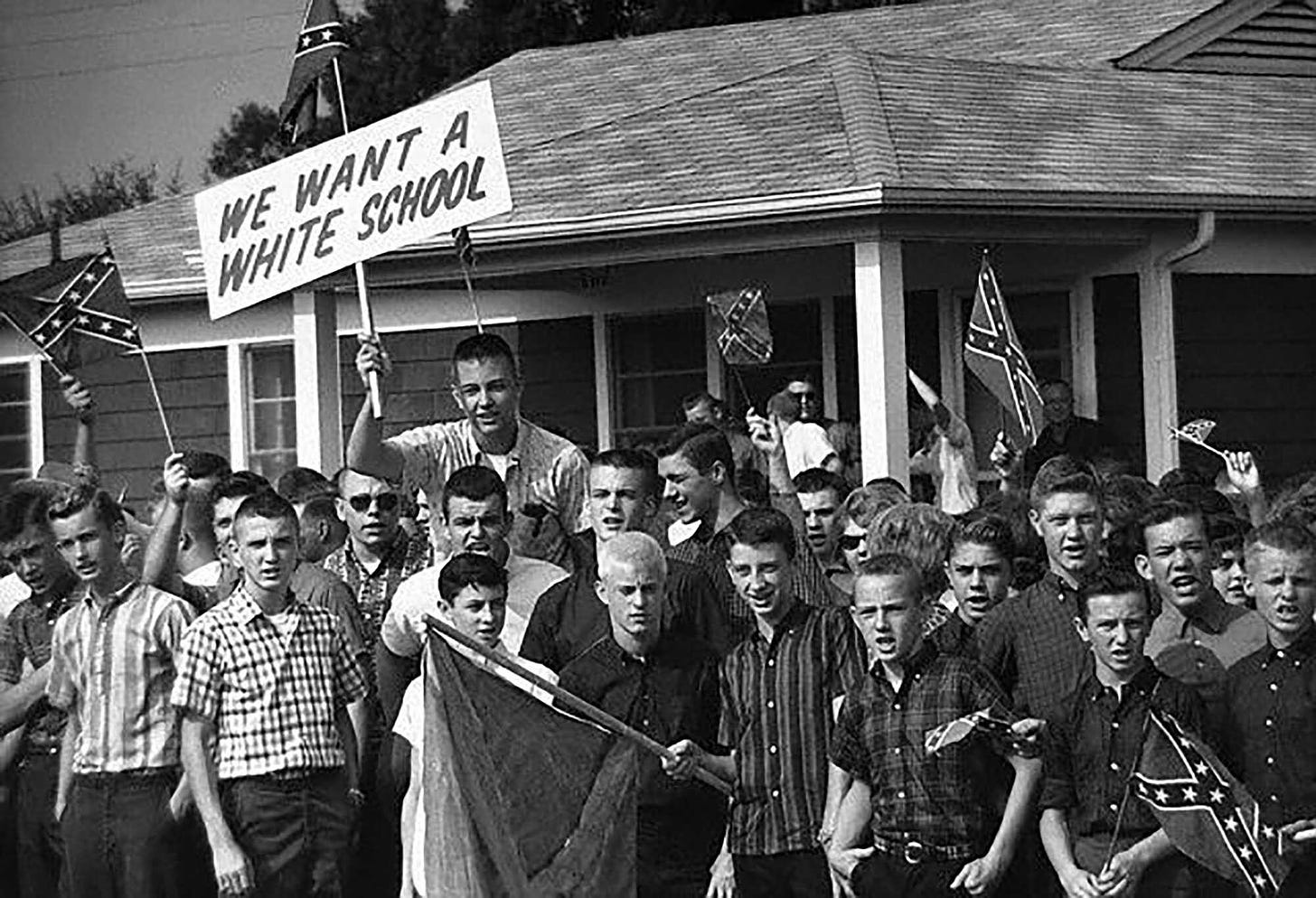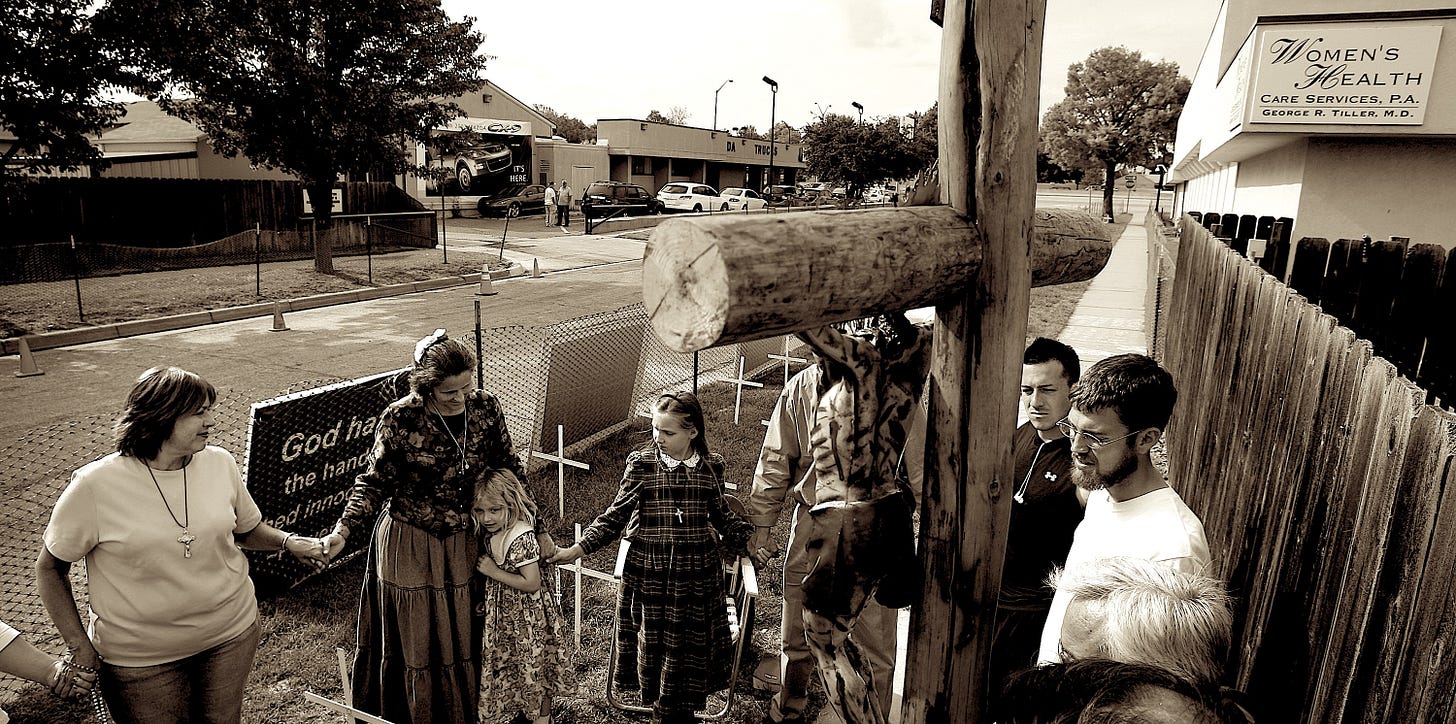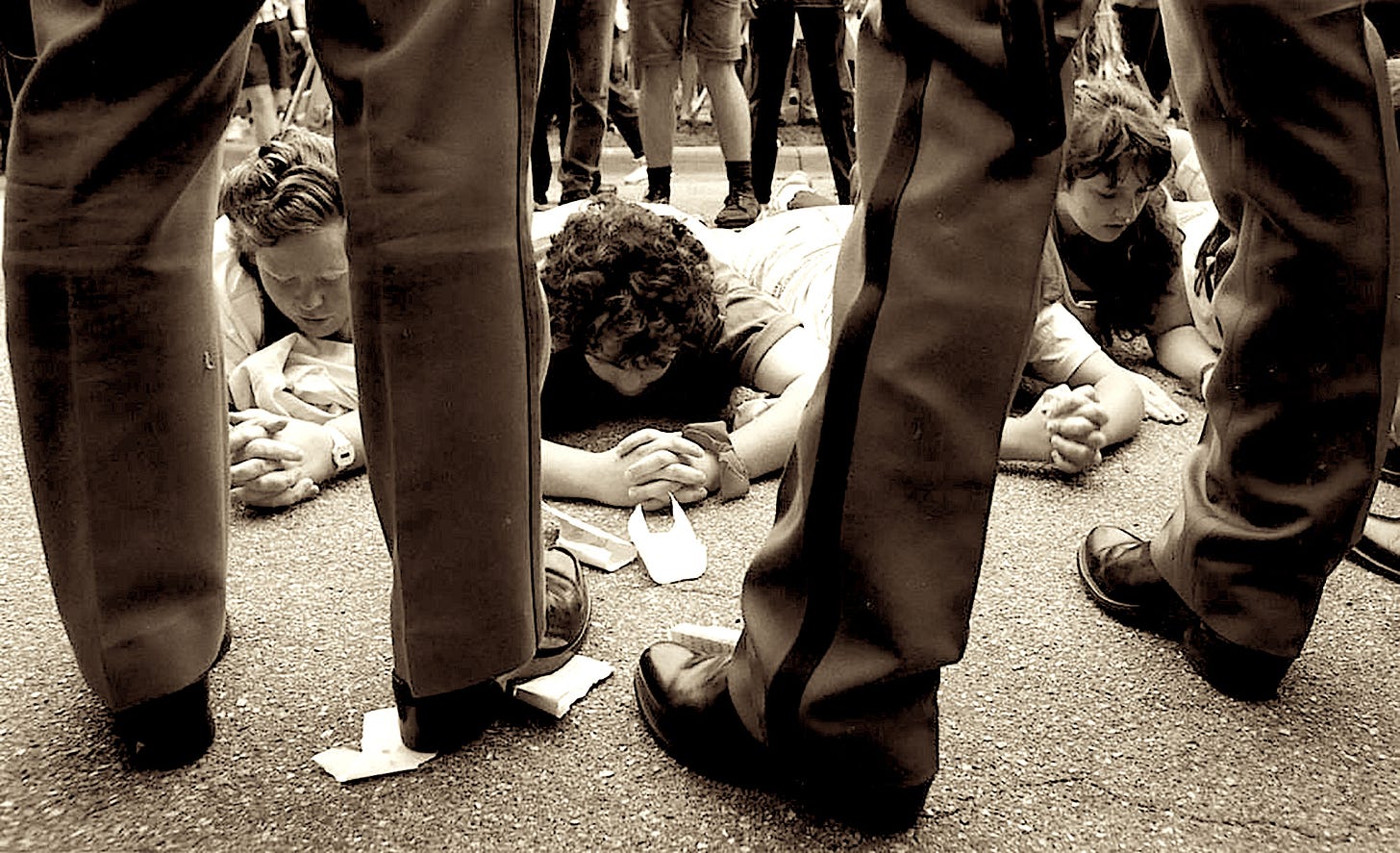In 2018, a woman walked free after twenty years in prison. In wire photos from her 1993 trial, 46-year-old housewife Rachelle Renee “Shelley” Shannon had long dark hair, cut in an unfashionable fringe, and round coke-bottle glasses, her head cast down and her body bundled in a trench coat against the cold wind of a Kansas autumn. Months earlier, she had flown to Oklahoma City from her home in Oregon, and then driven hundreds of miles to ambush workers at a women’s health clinic that had long been a target of anti-abortion extremists. With a hail of bullets, and through a blizzard of broken car-window glass, she shot Dr. George Tiller, one of the nation’s few providers of late-term abortions, in both of his arms. He went back to his clinic the following day swathed in bandages; Shannon was arrested at the Oklahoma City airport, to be deposited in a Wichita jail.
Later, during her incarceration, she would admit—with pride, not remorse—to an interstate string of arsons and butyric-acid attacks targeting nine abortion clinics in Oregon, California, and Nevada. Since 1988, Shannon had been involved in the radicalized anti-abortion movement, engaging in protests that obstructed clinics and trespassed on their property, resulting in several arrests. Over the ensuing years, her commitment became increasingly violent, dedicated to eradicating abortion in the U.S. by any means necessary, including murder. She had written dozens of letters to Michael David Griffin, who had murdered abortion provider Dr. David Gunn in Pensacola, Florida in March 1993. A month before her attempted murder of Dr. Tiller, Shannon visited John Brockhoeft, who was serving time in a Kentucky prison for firebombing an abortion clinic in Cincinnati. (Decades later, Brockhoeft would participate in the January 6th insurrection at the U.S. Capitol.)
The Shelley Shannons of the world—along with an assortment of firebombers, arsonists, attackers and the crowds that routinely picket abortion clinics, harassing patients and holding up placards splattered with gore—believe intensely in the notion of a war against the unborn, and that they are fighting against public murder. Shannon and her compatriots in the Army of God no doubt celebrated the culmination of their homicidal efforts in 2022, when a new Supreme Court stacked explicitly with members of the Christian right overturned Roe v. Wade and let loose a series of increasingly restrictive state laws criminalizing abortion providers, patients and supporters. This decision released a tide of maternal death that would put any individual firebomber, arsonist or assassin to shame.
In Missouri, lawmakers have recently pre-filed legislation that defines the beginning of personhood as the moment of fertilization. Under the “Abolition of Abortion Act,” IUDs and emergency contraception such as Plan B would be categorized as forms of murder, as Jessica Valenti points out in her indispensable Abortion, Every Day newsletter, and criminal charges could be applied to anyone who obtains or helps anyone obtain these as well as an abortion. In Texas, Attorney General Ken Paxton went on a public crusade, threatening criminal penalties to prevent a woman from obtaining a medically necessary abortion, despite the fact that said woman had gone to the extraordinary step of obtaining a court order determining that the abortion was medically necessary: a fatal fetal abnormality meant that the child she was carrying would inevitably die. The woman in question, Kate Cox, fled the state to obtain an emergency abortion; the Attorney General had specifically threatened her Texas doctor with imprisonment. The Texas Supreme Court justice who ruled against Cox has bragged that, in his private life, he has been arrested no fewer than 37 times for harassing abortion providers. Such are the wages of a movement built on terror and sustained by state fiat.
The Sword and the Sandwich is a newsletter about deadly serious extremism and serious sandwiches. Please consider supporting this work with a paid subscription:
But abortion wasn’t always at the heart of evangelical activism. As Randall Balmer, a professor of religion at Dartmouth College, has pointed out, opposition to abortion wasn’t a central or even a fringe tenet of conservative evangelical activism until well after the Roe v. Wade decision. Throughout most of the twentieth century, abortion was considered a Catholic issue, one viewed with either apathy or distaste by the majority of American Protestants. As late as 1976, the Southern Baptist Convention—then and now a central organization in the evangelical landscape—passed a resolution calling for the legalization of abortion.
Future anti-abortion firebrands at the center of the movement, like James Dobson and Jerry Falwell, held their tongues in the 1970s, even acknowledging the Bible’s silence on the subject. At the time, the religious right was engaged in a ferocious backlash against school integration, struggling to retain the tax-exempt status of the parochial “segregation academies” they had been set up across the South. Ballmer identifies the stripping of Bob Jones University—a fundamentalist college in South Carolina infamous for its refusal to admit Black students, and subsequent prohibition on interracial dating—of its tax-exempt status by the IRS in the 1970s that truly ignited evangelicals as a political force to be reckoned with.
It took religious and political leaders like “Robespierre of the Right” Paul Weyrich, a canny operator with a stacked Rolodex of business contacts, and famed preacher Jerry Falwell, acting in concert, to harness the newly inflamed political passion of evangelicals and redirect it to a cause that might win them more converts. “Instead of the Religious Right mobilizing in defense of segregation, evangelical leaders in the late 1970s decried government intrusion into their affairs as an assault on religious freedom, thereby writing a page for the modern Republican Party playbook,” Ballmer writes. “Opposition to abortion, therefore, was a godsend for leaders of the Religious Right because it allowed them to distract attention from the real genesis of their movement: defense of racial segregation in evangelical institutions.”
It wasn't long before this struggle for “religious freedom”—the freedom to instruct children in all-white religious schools without paying a dime in taxes for it—was transmuted into the more broadly appealing fixation on abortion rights. To a certain segment of the public, it looks more sympathetic to express tragic concern for a fetus—or, as anti-choice rhetoric puts it, “a preborn child”—than to militate for school segregation. Accordingly, the initial evangelical approach to feminism expressed itself as opposition to the movement for women’s rights in general, and a desire to see women subjugated under the yoke of a divine mandate.
By the 1970s, the very public association of Southern white churches with segregationism had damaged the image of the Christian right. In adopting the anti-abortion struggle, evangelicals saw themselves as engaged in a battle for the civil rights of the unborn—a new conflict every bit as morally weighty as the struggle against slavery or Jim Crow. The battle against abortion was the new abolitionism, and this time, they would be on the right side of history. That the adoption of an identity as abolitionists—explicitly, in some cases—was somewhat grotesque coming from a group most famous for having stood squarely in the path of integration and civil rights was besides the point; this was a chance to redress a past moral failing by donning its own vestments.
Comparisons between abortion and the Holocaust, slavery, racism, and other historical ills have been part of the Christian-right’s case against Roe from the very beginning. One early example was James T. Burtchaell, a professor at Notre Dame College, writer for Christianity Today, and staunch anti-abortion advocate. In his 1984 book, “Rachel Weeping: The Case Against Abortion,” he made these comparisons explicit. “At the yeoman's level... abortion facilities are picketed, prospective abortors approached, and clinics burnt. Some of this is illegal; all of it is bitterly resented. But it has an interesting precedent in the energetic efforts many antislavery believers made to thwart their racist adversaries,” Burtchaell wrote. “In a way, the freeing of the slaves and the burning of the clinics displayed—more clearly than published remonstrances—the smoldering vehemence against slavery and against abortion.”
Adopting the language of abolitionism—and the world-historical moral certitude it represents—is just one of a multiplicity of rhetorical strategies adopted by the Christian right in its battle against abortion. In order to bolster that mission, anti-abortion lawmakers often gird their claims with a fixation on selectively-applied biology. This discriminatory embrace of science dates to the earliest years of the Christian right’s national abortion obsession. In 1979, a curious duo—wild-haired preacher Francis Schaeffer and Dr. C. Everett Koop, then-surgeon-in-chief of the Children’s Hospital of Philadelphia, later to become Surgeon General under Ronald Reagan—created a book and film series called Whatever Happened to the Human Race? They toured the film series, a four-hour God-drenched critique of abortion, around the United States, converting the masses to the anti-abortion cause. The films—lo-fi, with the overall tenor of a training video for some ghoulish workplace—were peddled to millions, winning converts to the anti-abortion cause through a combination of solemn preaching, scientific fact, and a judicious helping of fire and brimstone.
Given the abundance of florid rhetoric on offer, it was a short step from speech to militant action. In the wake of the Christian right’s campaign against Roe, a wave of violence against abortion seekers and providers was unleashed that has not let up for half a century. One of many militant anti-abortion groups, The Army of God was a sprawling, leaderless network of would-be killers, and it made the 1990s the high-water mark of a half-century of violence against abortion providers and their patients. In 1996, Eric Rudolph, a carpenter and member of a militant white supremacist Christian sect, set off a bomb at the Olympic Games in Atlanta, killing two and injuring over a hundred people. When Rudolph was arrested years later, he admitted to prior bombings of two abortion clinics, one in an Atlanta suburb and another in Birmingham, Alabama.
Armed with their own warped righteousness, people like Shannon, Griffin, Rudolph and Brockhoeft set out to burn down clinics and murder their staff as part of a divine mission to stop what they perceived as a perpetual holocaust of infant murder in the United States.
In 2009, a decade and a half after Shannon’s attempted murder of George Tiller, another soldier in the Army of God, a Kansas convenience-store clerk named Scott Roeder, succeeded at what she had attempted. In the intervening years, right-wing media maintained an obsessive fixation on Tiller, targeting the doctor for further violence. Between 2005 and 2009, Salon reports, Fox News’s Bill O’Reilly referenced “Tiller the Baby Killer” on 29 separate episodes of his show, comparing him to Hitler, Mao and Stalin and accusing him of running a “death mill.” Roeder was one of many who listened to this invective—and drew it to its logical conclusion. As Dr. Tiller worshiped at a Sunday service at the Reformation Lutheran Church in Wichita, Roeder shot him point-blank in the head and fled in a powder-blue Ford Taurus.
The contact email on Army of God’s website, displayed under a photo of George Tiller’s casket, is, to this day, Glory2Jesus@ArmyofGod.com. The website is festooned with garish images of dead babies, with a slate of murderers and arsonists hailed as “AMERICAN HEROES.” As in most cases of extremist movements, those who take up the instruments of murder reflect the distilled essence of more broadly-held views, and inspire silent sympathy or open admiration in those more inclined to remain within the law. Years before she picked up a weapon, Shelley Shannon took part in anti-abortion protests at clinics that have, in subsequent decades, become so routine around the country that clinic escorts, whose goal is to shield patients from harassment or violence, are sought-after volunteers.
When Shelley Shannon was convicted, a federal judge declared her a terrorist. She was, and likely remains so, according to the abortion providers quoted on record expressing their trepidation about her release. She was a part of one of the most sustained, and successful, terrorist movements in U.S. history, a twentieth-century analogue to the terror that accompanied Reconstruction. The five-decade campaign of assassinations, arsons, bombings, stalkings, blockades and death threats has made providing abortions, supporting abortions, and receiving abortions increasingly dangerous endeavors. Looking back on Shannon’s terrorism and those of her associates decades later, what is most striking is how much closer to the mainstream her views have become, as an uncompromising embrace of violence becomes an indelible part of the religious right.
Routine anti-abortion protests—like the “Summer of Mercy” movement, created by far-right Christian group Operation Rescue, that blockaded Kansas clinics in 1991 and 2011—are filled with children, trained from their earliest days to take part in the politics of obliterating a woman’s right to choose. Children and teens make up the majority of the crowds that flood Washington, D.C. each year in the antiabortion movement’s annual “March for Life.” Expressing the certainty of Scripture and bending scientific knowledge to their own ends, the terrorists and the movement from which they arose have created laws around the country that put pregnant women and doctors in fear for their lives. From arson to legislation is not so far a distance as those who maintain a veneer of conservative respectability would have you believe. If a woman dies in a bombing, or if she dies of sepsis because a law prohibits the removal of a stillborn child from her womb, she is still dead. Terrorist violence and increasing legal jeopardy have combined to make women’s control of their bodies something beyond reach for tens of millions of Americans. All of it has been done in the name of God. And it is advancing, always advancing, an army of god on the march.











The influence of Francis Schaffer goes far past being a wild-haired preacher. He wrote a series of books which were foundational texts in many private evangelical schools -- including my first college. "The God Who Is There" was his attempt at making an argument for God that would be applicable in the post civil rights world. "Escape from Reason" was a repudiation of Nietzsche and Immanuel Kant -- making post-modern philosophy and theology into a straw man associated with war crimes, insanity, and drug use. Then "He is there and He is Not Silent" builds on the other two to make a case that abortion is the modern version of the war crimes and horrors of the first 2/3rds of the 20th Century.
As Christine O'Donnell and Sarah Palin make clear, anyone who went to a Christian college in the 1980's and 1990's was exposed to these books. (Yes, I was as well. Any comfort and confidence I gained from them crumbled when I saw evangelicals fomenting and even profiting off the civil war in Guatemala where I spent some time in 1989 as part of a mission trip.)
Francis Schaeffer's son, Frankie, is a gift to the world, debunking his father's academic words by the very comfortable European life the man enjoyed while legions were trained to fear and hate the Europeanization of the U.S. through his books. Oh, and also making plain the misogyny that was wrapped in such beautiful words in those books.
This article brings back memories. In 1991, my wife and I drove overnight from St. Paul to join a counterprotest against Operation Rescue's Summer of Mercy in Wichita. It was frustrating, because among the speakers at the counterprotest, only Eleanor Smeal proposed an obvious action, which was to surround the clinic with pro-choice people and physically block the OR people from disrupting Dr. Tiller's clinic. But it was really an eye-opener.
A year later, we happened to drive by the Robbinsdale Clinic (MN) and saw the maniacs jumping on the front of cars waiving plastic fetuses. I went back there most Saturdays for about two years to join the clinic escorts. In 1993, OR came to the Twin Cities. We trained scores of college students and other on escorting and clinic defense. Soon it became obvious that the wind had gone out of their sails; they were outnumbered by the defenders.
Later that year, I drove to Des Moines, picked up three comrades, and drove all night to Denver where OR had promised to shut down all the clinics during the Pope's visit. They were defeated in Denver.
Later that year (or maybe 1994), I was asked to be a guard of Dr. Tiller when he addressed a pro-choice ecumenical group in St. Paul. In the course of my duties, I had a chance to chat with him. Of course I was shaken and angered when he was murdered, although I wasn't surprised.
I'll turn 75 in a couple of weeks, and all this was a long time ago. But I consider myself fortunate to have had the opportunity to participate in this struggle for human rights. Your generation will have their chance too.